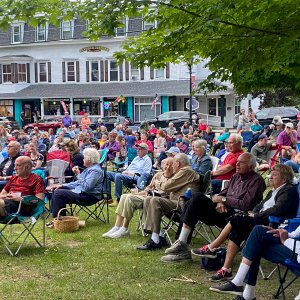Seeds – Venturing Forth
| Published: 10-14-2023 9:00 AM |
The days are getting shorter, nights are cooler – yes fall is in the air and so are seeds. Many plants release their seeds in autumn and some of those packages of future life travel to new locations on the wind. It is ideal for seeds to sprout away from the parent plant to reduce competition for resources and to populate new areas. Relying on the wind is one of the various strategies that plants use to disperse their seeds.
Milkweed pods have been cracking open to discharge their white plumes of fluff that catch the lightest passing breeze and float up into the air. At the base of the fluff hangs a small wispy brown seed, just heavy enough to bring it down to the earth, like a person with a large parachute.
One milkweed plant produces an average of 700 seeds but they must land on well-drained soil in full sun in order to sprout into a new plant next spring. Obviously not all 700 produce a new plant. Many land in unfavorable locations, get eaten by a rodent or bird, or sprout only to get mowed down because they are considered a weed. Part of the reason the monarch butterfly has been declining is because milkweed plants, which are food for the caterpillars, have been removed from many landscapes. Allowing the seeds to grow in meadows or around the edge of yards will increase the chances that the rebounding monarch population will have plentiful food next summer.
Other plants that use the parachute method to disperse their seeds at this time of year include goldenrod, asters, wild lettuce and thistle. Downy fibers from these flowers are so light they fly up into the air providing added loft which enables them to come down quite a distance from their source.
Several tree species produce seeds with papery wings that also take advantage of the wind. Since these seeds grow on branches high in the canopy, gravity brings the seeds down. If you look to the top of white pines this year, you’ll seed they are LOADED with cones, following an every 3-5 high production cycle. Increased surface area on the winged seeds creates drag and slows the descent, enabling a longer flight to more distant ground. Pine seeds when released from the cones, can travel 200-700 feet. Ash, maple, and basswood, seeds also spin and twirl like a propeller as they disperse. Elm seeds are in the center of a circular membrane, so they soar like a tossed disc.
Wind is not the only mechanism for moving seeds. Jewelweed or touch-me-not is a dainty plant that grows along paths and roadsides often where the ground is a bit damp. When it’s orange funnel-shaped flowers mature into seeds, they form a capsule that is sensitive to touch. If an animal brushes by them, or a curious person gives a ripe seed a quick, gentle pinch, the capsule explodes and catapults its seeds several feet from the plant. If you have never done this, go in search of a patch of jewelweed. You will quickly learn why some of its other names are snapweed, kicking horse and quick-in-the-hand.
What would autumn be like without acorns, beechnuts and hickory nuts underfoot? These seeds depend on animals to move them around and contain added fat and protein to entice the critters to collect and store them for their winter food supply. Many of these seeds will be consumed by squirrels, chipmunks and blue jays. But they never retrieve their entire cache and seeds that are forgotten or lost may sprout into new seedlings in the spring helping to produce future forests.
Berries and fruit provide another incentive for animals to consume plant parts. While the juicy flesh of grapes, wild cherries, and even poison ivy is digested by birds and mammals, hard seeds within those fruits pass through the digestive tract and are deposited, usually far from where the consumer picked it up. The added benefit of this dispersal method is that the seed is dropped with a fresh batch of animal waste fertilizer!
Article continues after...
Yesterday's Most Read Articles
This autumn as you wander the woods and fields, watch for seeds and examine their structures. See if you can determine what method they might use to carry their genes to new territories and into the future.







 Lavender haze: Purple fields bloom at Warner farm
Lavender haze: Purple fields bloom at Warner farm Arts in the Park returns for July
Arts in the Park returns for July Hopkinton art gallery showcases “Creativity Beyond Convention”
Hopkinton art gallery showcases “Creativity Beyond Convention” AROUND CONCORD: Your guide to free summer music
AROUND CONCORD: Your guide to free summer music
